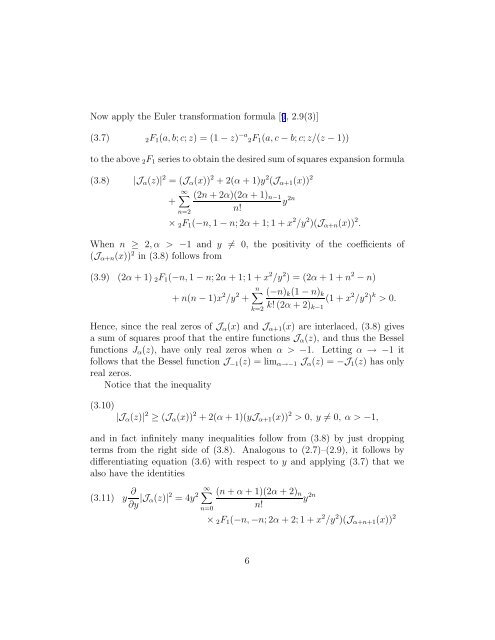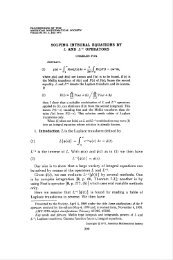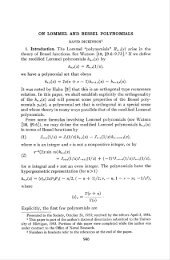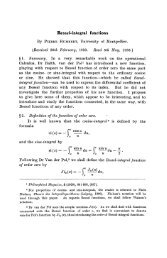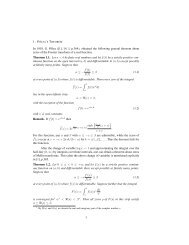G. Gasper Using sums of squares to prove that ... - Fuchs-braun.com
G. Gasper Using sums of squares to prove that ... - Fuchs-braun.com
G. Gasper Using sums of squares to prove that ... - Fuchs-braun.com
Create successful ePaper yourself
Turn your PDF publications into a flip-book with our unique Google optimized e-Paper software.
Now apply the Euler transformation formula [9, 2.9(3)]<br />
(3.7)<br />
2F 1 (a, b; c; z) = (1 − z) −a 2F 1 (a, c − b; c; z/(z − 1))<br />
<strong>to</strong> the above 2 F 1 series <strong>to</strong> obtain the desired sum <strong>of</strong> <strong>squares</strong> expansion formula<br />
(3.8)<br />
|J α (z)| 2 = (J α (x)) 2 + 2(α + 1)y 2 (J α+1 (x)) 2<br />
∞∑ (2n + 2α)(2α + 1) n−1<br />
+<br />
y 2n<br />
n!<br />
n=2<br />
× 2 F 1 (−n, 1 − n; 2α + 1; 1 + x 2 /y 2 )(J α+n (x)) 2 .<br />
When n ≥ 2, α > −1 and y ≠ 0, the positivity <strong>of</strong> the coefficients <strong>of</strong><br />
(J α+n (x)) 2 in (3.8) follows from<br />
(3.9) (2α + 1) 2 F 1 (−n, 1 − n; 2α + 1; 1 + x 2 /y 2 ) = (2α + 1 + n 2 − n)<br />
n∑<br />
+ n(n − 1)x 2 /y 2 (−n) k (1 − n) k<br />
+<br />
(1 + x 2 /y 2 ) k > 0.<br />
k! (2α + 2) k−1<br />
Hence, since the real zeros <strong>of</strong> J α (x) and J α+1 (x) are interlaced, (3.8) gives<br />
a sum <strong>of</strong> <strong>squares</strong> pro<strong>of</strong> <strong>that</strong> the entire functions J α (z), and thus the Bessel<br />
functions J α (z), have only real zeros when α > −1. Letting α → −1 it<br />
follows <strong>that</strong> the Bessel function J −1 (z) = lim α→−1 J α (z) = −J 1 (z) has only<br />
real zeros.<br />
Notice <strong>that</strong> the inequality<br />
(3.10)<br />
|J α (z)| 2 ≥ (J α (x)) 2 + 2(α + 1)(yJ α+1 (x)) 2 > 0, y ≠ 0, α > −1,<br />
and in fact infinitely many inequalities follow from (3.8) by just dropping<br />
terms from the right side <strong>of</strong> (3.8). Analogous <strong>to</strong> (2.7)–(2.9), it follows by<br />
differentiating equation (3.6) with respect <strong>to</strong> y and applying (3.7) <strong>that</strong> we<br />
also have the identities<br />
(3.11) y ∂ ∂y |J α(z)| 2 = 4y 2 ∞ ∑<br />
n=0<br />
k=2<br />
(n + α + 1)(2α + 2) n<br />
y 2n<br />
n!<br />
× 2 F 1 (−n, −n; 2α + 2; 1 + x 2 /y 2 )(J α+n+1 (x)) 2<br />
6


